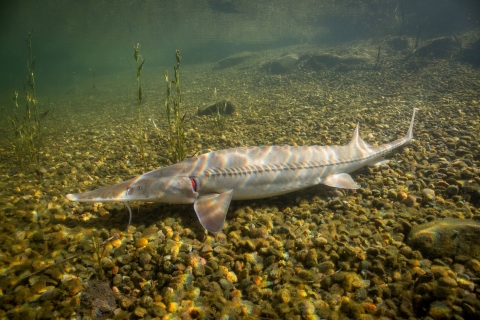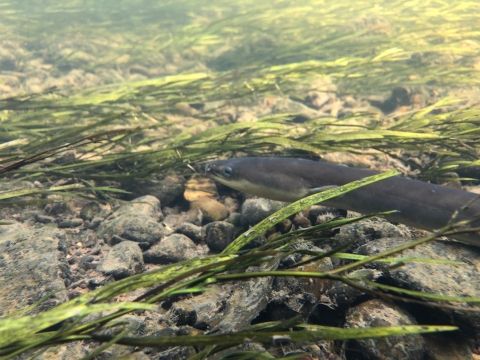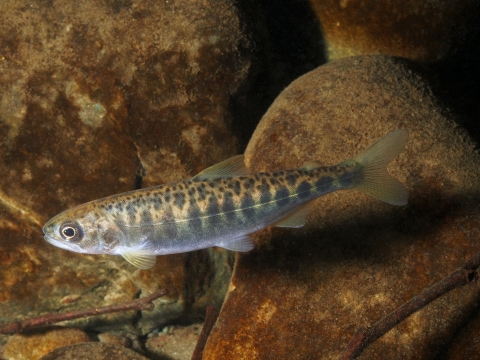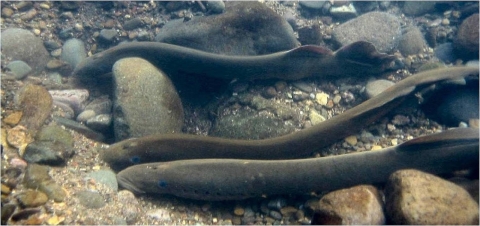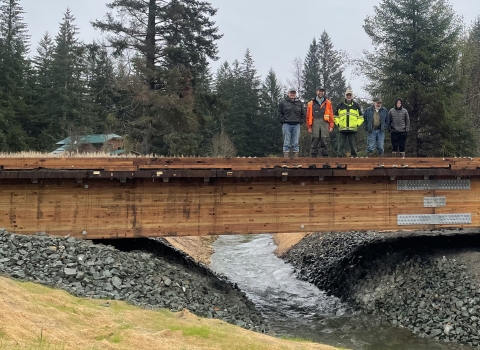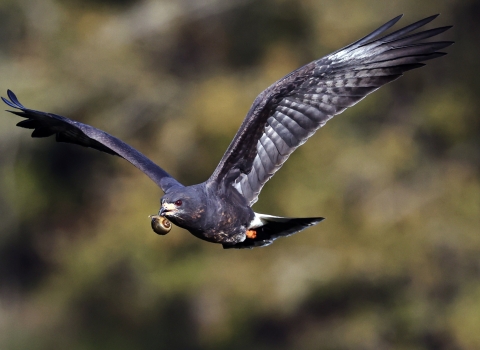When someone mentions the word migration, what’s the first critter that comes to mind?
As someone who spends every day working for fisheries, I’m ashamed to admit that I automatically think of birds. BIRDS! (Please don’t disown me, fellow fish friends!)
Birds have historically had a really great marketing team; we spend hours learning about their migratory patterns in elementary and middle school and step outside to see those iconic V-shaped swarms of geese flying overhead. Beautiful, majestic, and more importantly VISIBLE.
Hidden beneath the glistening surface of your nearby streams and rivers, however, are the unsung heroes of the migration world...FISH! And not just fish, but all sorts of interesting aquatic critters. Across the world, aquatic animals are traveling unseen through streams, rivers, and lakes to live their splashiest lives – feeding, breeding, and catching some good waves.
They're kind of a big deal
Lucky for these fish, the world gathers together every two years to celebrate their epic journeys on World Fish Migration Day – happening this year on May 25! The day is dedicated to improving our understanding of migratory fish and raising awareness of the challenges they face during their migrations.
Meet the MVPs
Before we get into migration challenges and our efforts to help these mysterious marvels, we want to give you a peek into some of the Migration MVPs of the aquatic community (that stands for Most Valuable Poisson for all of you French-speaking fish lovers!). If you want to learn more about these amazing Migration MVPs, be sure to check out our Fish Need to Move fact sheets that are full of cool info!
Pallid sturgeon
Migration style: Chill drifters
Pallid sturgeon often make long upstream journeys looking for the perfect place to spawn. Their tiny just-hatched larvae will then drift in the river current for 10 days or more before settling to eat and grow.
Steelhead trout
Migration style: Auto pilots
Steelhead trout are born and spend the first part of their lives in freshwater, then migrate out to the ocean where they grow to adulthood. They then migrate back to freshwater, to the same river where they were born, to spawn a new generation of fish.
American eel
Migration style: Long haul truckers
American eels begin their lives in the Sargasso Sea and spend their early years drifting on ocean currents for over 3,700 miles to the freshwater rivers, streams, and lakes where they will spend most of their lives.
Canoe Creek clubshell
Migration style: Hitchhikers
The federally endangered Canoe Creek clubshell mussel relies on host fish to shuttle its babies upstream. Reconnecting habitat and streams for fish also then leads to increasing habitat for these important water-filtering mussels; it's a win-win!
Alaska Chinook salmon
Migration style: Food motivated
Chinook salmon are born in freshwater, where they stay for 1-2 years before migrating to the sea in search of the ultimate seafood buffet to feast on. This buffet comes at a price though, as these juveniles have to navigate big rivers, tiny streams, and everything in between! After 2-5 years of bulking up, they go all the way back to freshwater for spawning!
Pacific lamprey
Migration style: Smooth sailing
One thing to know about Pacific lamprey, they are NOT jumpers! Some of the best ways to conserve and protect them include installing special Lamprey Passage Systems that allow them to pass over dams, since they can’t use traditional fish ladders designed for jumping fish.
Some big dam obstacles, but help is on the way!
Unfortunately for all of these epic migrators, their paths aren’t always free of obstacles. Over six million barriers, like obsolete dams and poorly designed road culverts, can keep fish, and other aquatic species from moving freely to feed, migrate, and reproduce. As an added bummer, these barriers don’t just fragment aquatic habitats, but also undermine the health of rivers, reduce fishing opportunities, and are often more susceptible to flooding or drought.
Luckily we have an AMAZING team working hard to remove these outdated and obsolete aquatic barriers! Our National Fish Passage Program works with communities, Tribes, and private landowners to help them remove barriers and restore rivers for the benefit of both fish and people. Fortunately, the Bipartisan Infrastructure Law, signed in November 2021, invested $200 million for the Program to restore fish and wildlife passage by removing in-stream barriers and providing technical assistance. Since 2022, 122 projects have been selected to receive roughly $143 million in fish passage fish passage
Fish passage is the ability of fish or other aquatic species to move freely throughout their life to find food, reproduce, and complete their natural migration cycles. Millions of barriers to fish passage across the country are fragmenting habitat and leading to species declines. The U.S. Fish and Wildlife Service's National Fish Passage Program is working to reconnect watersheds to benefit both wildlife and people.
Learn more about fish passage funding, making migration for fish and other aquatic animals a whole lot easier.
How can you celebrate World Fish Migration Day?
Spread the word about fish migration!
This one’s easy peasy…tell your friends/family/frenemies how cool fish are and how far they travel for migration! (hint: sending them this link makes this one even easier!)
Join a World Fish Migration Day event near you!
This is a global celebration with events all over the world! Listen to educational talks, participate in cleanups, release fish, the options are abundant! Pop on over to the World Fish Migration Day events page to search or an event near you.
Get involved in fish passage!
The National Fish Passage Program provides financial and technical assistance to support projects that improve community infrastructure resilience, rebuild fish populations, improve recreational and commercial fisheries, and restore the beauty of free-flowing waters. Project proposals can be initiated by any individual, organization, government, or agency, in cooperation with their local Fish and Wildlife Conservation Office. Contact a Fish Passage Coordinator in your area or contact your local Fish and Wildlife Conservation Office to discuss the project and learn more about the technical and financial assistance that is available. By working together, we can help to restore healthy fisheries and reverse the declines in migratory freshwater fish across America.

